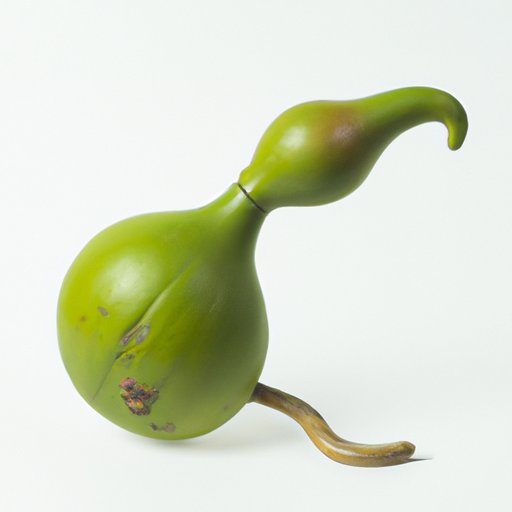What is a Gourd? Exploring the History, Uses, and Benefits of this Versatile Plant
Gourds have been used by humans for thousands of years in various ways ranging from practical and functional to artistic and decorative. These versatile plants are grown in many parts of the world and come in countless shapes and sizes, but what exactly is a gourd? This article aims to answer this question and provide readers with an in-depth exploration of the history, uses, and benefits of gourds.
Defining the Gourd
At its most basic level, a gourd is a plant that belongs to the Cucurbitaceae family, which also includes cucumbers, melons, and pumpkins. Gourds are typically characterized by their hard outer shell and, in many cases, their hollow center. While they are often thought of as decorative objects, gourds have a long history of being used for practical purposes as well. The versatility of gourds is due to their unique characteristics such as their toughness, durability, and waterproof qualities.
Some examples of how gourds can be used include:
- Containers for food and water
- Musical instruments (such as the maracas)
- Decorative objects
- Medicinal remedies
- Birdhouses and feeders
- Lanterns and light fixtures
Types of Gourds
There are many different types of gourds, each with their own unique characteristics and uses. Some common types of gourds include:
- Bottle gourds
- Snake gourds
- Bitter melons
- Spine gourds
- Wax gourds
Bottle gourds, for example, are often used for their edible flesh but can also be dried and made into containers or musical instruments. Snake gourds are a long and cylindrical type of gourd that are often used in cooking, while bitter melons are known for their medicinal properties and are eaten as a vegetable in many parts of the world.
The History of Gourds
Gourds have been used by humans for thousands of years and have played a significant role in many different cultures. In ancient times, gourds were used for practical purposes such as storage containers and water vessels. In some cultures, gourds were also used in spiritual or religious ceremonies.
The use of gourds in art can also be traced back to ancient times. In some cultures, gourds were used to make masks or were decorated with elaborate carvings or designs. Gourds were even used to make intricate musical instruments like the sitar in India and the quena in South America.
Gourds in Art and Design
In modern times, gourds continue to inspire artists and designers around the world. Gourds have been incorporated into decorative art and textiles in many different ways, from intricately carved designs to brightly colored and painted patterns.
Gourd art has become a popular form of expression for many artists, with some creating elaborate sculptures or detailed carvings using gourds as their canvas. Gourd artists often use a variety of techniques, including woodburning, carving, and painting, to create their works of art.
Health Benefits of Gourds
In addition to their many practical and artistic uses, gourds also offer a number of health benefits. Many types of gourds are low in calories and rich in vitamins and minerals. For example, bottle gourds are a good source of fiber, potassium, and vitamin C, while bitter melons are high in antioxidants and have been shown to have anti-inflammatory and anti-cancer properties.
Gourds can be a particularly good choice for people looking to maintain a healthy weight, as their low calorie count and high fiber content can help promote feelings of fullness and reduce overall calorie intake.
How to Grow Gourds
Growing gourds in your own garden can be a fun and rewarding experience. Here’s a step-by-step guide for how to do it:
- Prepare the soil – Gourds need well-draining soil that is rich in nutrients. Choose a sunny location in your garden, and till the soil to a depth of about 12 inches.
- Plant the seeds – Gourd seeds can be planted directly in the ground or started indoors and then transplanted outside. Plant the seeds about an inch deep in the soil and keep them moist.
- Water regularly – Gourds need consistent moisture to thrive. Water them regularly, being careful not to overwater as this can lead to root rot.
- Harvest the gourds – Harvest gourds once they are fully mature and the vines have started to wither. They can then be dried and used for a variety of purposes.
Gourd Crafts and DIY Projects
If you’re feeling creative, there are countless ways to incorporate gourds into your DIY projects and crafts. Here are a few ideas to get you started:
- Birdhouses – hollow out a gourd and add a small opening to create a unique birdhouse for your backyard
- Lanterns – carve designs into a gourd and add a small candle or light to create a beautiful and unique lantern.
- Musical instruments – use a dried gourd as a base to create your own musical instrument, such as a maraca or drum.
Conclusion
Gourds have a fascinating history and are a versatile plant that can be used in countless ways. Whether you’re interested in growing gourds in your garden, incorporating them into your art and design projects, or simply trying out some new recipes, there’s something for everyone in the world of gourds.
